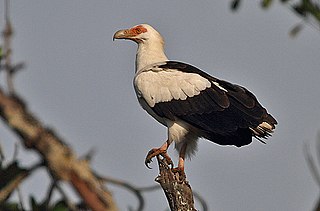
The palm-nut vulture or vulturine fish eagle, is a large bird of prey in the family Accipitridae. It is the only member of the genus Gypohierax.

Francolins are birds in the tribe Gallini that traditionally have been placed in the genus Francolinus, but now commonly are divided into multiple genera.

The lanner falcon is a medium-sized bird of prey that breeds in Africa, southeast Europe and just into Asia. It prefers open habitat and is mainly resident, but some birds disperse more widely after the breeding season. A large falcon, it preys on birds and bats.

The blue-billed teal, spotted teal or Hottentot teal is a species of dabbling duck of the genus Spatula. It is migratory resident in eastern and southern Africa, from Sudan and Ethiopia west to Niger and Nigeria and south to South Africa and Namibia. In west Africa and Madagascar it is sedentary.

The Alaotra grebe, also known as Delacour's little grebe or rusty grebe, is an extinct grebe that was endemic to Lake Alaotra and its surrounding lakes in Madagascar.

The pygmy falcon or African pygmy falcon is a bird of prey native to eastern and southern Africa. It is the only species placed in the genus Polihierax. It is the smallest bird of prey on the African continent.

Temminck's courser is a bird in the pratincole and courser family, Glareolidae. It is a wader which lives in sub-Saharan Africa. It is noted for laying its dark ash-black eggs in the burnt bushes and grass of the African savannah.

The wildlife of Angola is composed of its flora and fauna.

The Sokoke scops owl is a highly localized species of scops owl found in lowland forests of Kenya and Tanzania. The greatest population of this species of owl is in the Cynometra-Manilkara forest, which is less than one-third of the Sokoke Forest. It is also found in the Afzelia-Cynometra forest.

The Coqui francolin is a species of bird in the family Phasianidae.

Latham's francolin or the forest francolin, is a species of bird in the francolin group of the family Phasianidae. It is the only member of the monotypic genus Peliperdix. It is found in Angola, Cameroon, Central African Republic, Republic of the Congo, Democratic Republic of the Congo, Ivory Coast, Equatorial Guinea, Gabon, Ghana, Guinea, Liberia, Nigeria, Sierra Leone, South Sudan, Tanzania, Togo, and Uganda.
The mottled swift is a species of bird in the swift family, Apodidae. It is one of two species in the genus Tachymarptis together with the alpine swift. It occurs widely in eastern Africa and locally in western Africa. It is found in Angola, Burkina Faso, Burundi, Cameroon, Central African Republic, Chad, Democratic Republic of the Congo, Ivory Coast, Eritrea, Ethiopia, Gabon, Ghana, Guinea, Kenya, Malawi, Mali, Mozambique, Nigeria, Rwanda, Sierra Leone, Sudan, Tanzania, Togo, Uganda, Zambia, and Zimbabwe.

The African grass owl is a species of owl in the barn owl family, Tytonidae.

The Kalahari scrub robin is a species of bird in the family Muscicapidae. It is sometimes known as the sandy scrub robin.

The ashy flycatcher is a species of bird in the Old World flycatcher family Muscicapidae. It is found throughout sub-Saharan Africa, excluding the drier areas of South Africa, Botswana, and Namibia, where it inhabits subtropical or tropical dry forest, subtropical or tropical moist lowland forest, and savanna. It has a disputed generic placement, with different authorities variously putting it in Muscicapa, Fraseria, or other genera. The species does not display sexual dimorphism, with both sexes being grey in colour with pale grey or white underparts.

The black-chested prinia is a species of bird in the family Cisticolidae. It is found in Angola, Botswana, Lesotho, Namibia, South Africa, Zambia, and Zimbabwe. Its natural habitat is dry savanna.

Gurney's sugarbird is a medium-sized passerine endemic to the mid- and high-altitude grassland velds in southern Africa. It belongs to the family Promeropidae, which contains one genus, Promerops, and two species. Gurney's sugarbird feeds on nectar from Protea bushes as well as on small insects. This bird is characterized by its long, graduated tail and decurved beak.

The Angolan Scarp savanna and woodlands is an ecoregion located on the coast of Angola, an area with a variety of habitats and rich in wildlife including many endemic birds and animals.

Bon Accord Dam is an earth-fill type dam located on the Apies River, some 15 km north of Pretoria. The dam comprises an earth embankment with a side spillway. The catchment area of the dam is 315 km2 and comprises primarily the City of Tshwane Metropolitan Municipal area in Gauteng, South Africa. It was established in 1923 and its main purpose is irrigation.
Kumbira Forest is a forest in Angola that is notable for its large variety of birds, including the Pulitzer's longbill, forest scrub robin and Gabela akalat. The forest is part of the Gabela Important Birding Area. It runs through the Cuanza Norte Province and Cuanza Sul Province. It was aimed to document the floristic diversity of Angola. The forest is located 10 kilometers away from Conda.



















